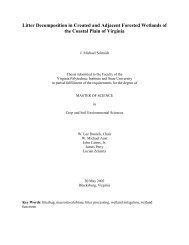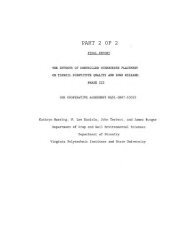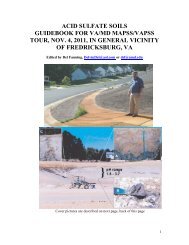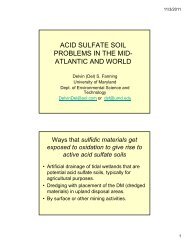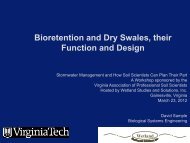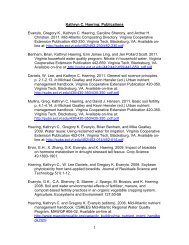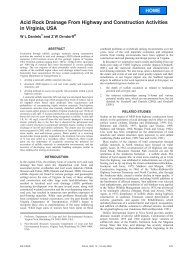Remediation of PAH-Contaminated Soils and Sediments: A ...
Remediation of PAH-Contaminated Soils and Sediments: A ...
Remediation of PAH-Contaminated Soils and Sediments: A ...
You also want an ePaper? Increase the reach of your titles
YUMPU automatically turns print PDFs into web optimized ePapers that Google loves.
persist in the soil (Alex<strong>and</strong>er, 1999). Interestingly, some microorganisms have<br />
evolved mechanisms to overcome decreased bioavailability in soils <strong>and</strong><br />
sediments such as production <strong>of</strong> biosurfactants to increase contaminant solubility<br />
or adhesion to the surface <strong>of</strong> the contaminant making it more accessible to<br />
degradation (This is discussed further in the Biological Techniques for Enhancing<br />
<strong>PAH</strong> Degradation Section).<br />
Consideration <strong>of</strong> <strong>PAH</strong> bioavailablity based on physical characteristics <strong>of</strong> the <strong>PAH</strong><br />
compound, sediment/soil characteristics <strong>and</strong> receptor organisms is important in<br />
the remediation <strong>of</strong> dredge sediments. The composition <strong>of</strong> <strong>PAH</strong> compounds<br />
might change during dewatering, where some LMW <strong>PAH</strong>s volatilize <strong>and</strong> HMW<br />
persist, soption to organic matter <strong>and</strong> clays may occur as the sediments age <strong>and</strong><br />
the microbial communities will undoubtedly change as the sediment shifts from<br />
anaerobic to aerobic. Thus an important question remains unanswered: do<br />
<strong>PAH</strong>s which are not currently bioavailable pose a threat with time to the<br />
environment or to humans?<br />
17



